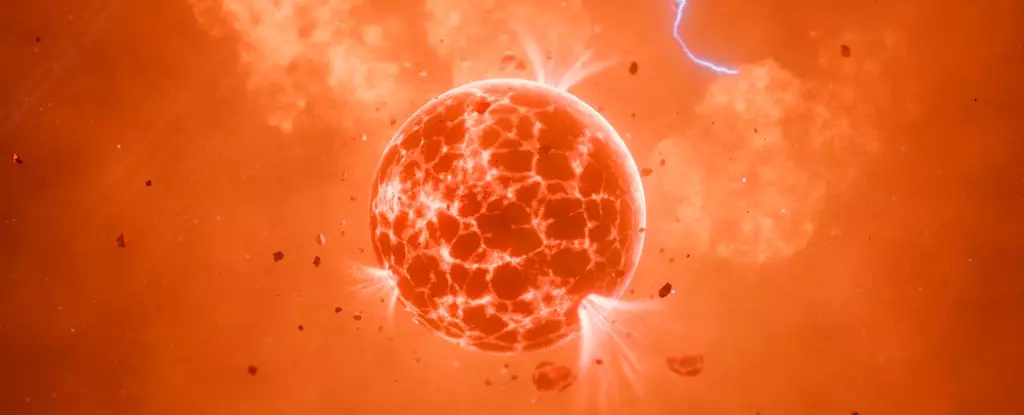In the vast realms of the universe, one of the most thrilling pursuits lies in the exploration of moons and their characteristics orbiting distant exoplanets. Recently, astronomers have turned their gaze toward a fascinating celestial body located approximately 635 light-years from Earth. This body, known as WASP-49b, has revealed compelling evidence that suggests the existence of a volcanic exomoon, exhibiting dynamic activity related to its environment. This article delves into the scientific findings that underscore the potential of a volcanic moon orbiting an exoplanet and the implications of this discovery.
The focus of this astronomical study centers around the unusual presence of a sodium cloud that appears to be linked to WASP-49b. Given that WASP-49b is classified as a gas giant—an apparent characteristic that precludes the existence of volcanic activity—it raises intriguing questions about the source of this sodium. Physicist Apurva Oza from the California Institute of Technology emphasized the peculiarity of the sodium cloud’s behavior. The cloud’s movement deviates from what would be expected if it were emitted solely from the planet’s atmosphere, suggesting instead that it could originate from a rocky, volcanically active moon.
Astrophysical phenomena such as this challenge preconceived notions regarding gas giants and their respective moons. In our own Solar System, moons significantly outnumber the planets, yet the detection of exomoons in distant systems has proven to be an arduous task. Detecting evidence of moons involves piecing together faint signals amid a universe saturated with noise and cosmic phenomena. The case of WASP-49b highlights the complexity scientists face when exploring beyond our familiar planetary neighborhood.
The story of WASP-49b has been unfolding since 2017 when initial research unveiled the unexpected presence of sodium in the planet’s atmosphere. Subsequent findings published in 2019 posited that this chemical signature could indicate an underlying volcanic moon, akin to Jupiter’s notoriously volcanic moon Io. The implications of this hypothesis sent shockwaves through the scientific community and sparked further investigations into the unique characteristics of this system.
While volcanic exoplanets are not unheard of, they typically share geological traits that hint at their dynamism, including orbital eccentricities and distinct temperature patterns. The discernment of volcanic activity within a gas giant’s influence remains unprecedented. However, Oza and his team meticulously addressed alternate explanations surrounding the sodium detection’s origins, systematically ruling them out and honing in on the exomoon theory.
To bolster their claims, the research team employed the European Southern Observatory’s Very Large Telescope to closely observe the WASP-49 system over several nights. The results confirmed earlier suspicions, revealing irregular intermittences in the sodium cloud’s visibility. Furthermore, the neutral state of the sodium indicated a constant source of production—an indication of an ongoing volcanic process.
Perhaps the most compelling evidence unveiled was the alignment of the sodium cloud’s timing with the theorized orbit of a volcanic exomoon rather than that of WASP-49b. Simulation models allowed the researchers to predict the moon’s orbital dynamics, revealing periodic appearances consistent with an exomoon that takes approximately eight hours to complete an orbit. These confirmations piece together a narrative of celestial activity leading to the unveiling of a dynamic landscape surrounding WASP-49b.
As mesmerizing as these findings may be, the saga of WASP-49b and its potential exomoon opens numerous avenues for further research. The gravitational interactions between the moon and WASP-49b imply a complex evolutionary history, potentially culminating in the exomoon’s destruction should its orbit decay significantly. This perspective not only enriches our understanding of satellite systems but also propels additional investigations into how moons evolve within the gravitational embrace of their parent planets.
The case of WASP-49b serves as a reminder that the universe is still full of surprises and untold wonders. As technology continues to advance, our understanding of celestial bodies multiplies, paving the way for significant breakthroughs in astrophysics and planetary science. The detection of exomoons remains a challenging endeavor, yet the scientific dialogue surrounding WASP-49b showcases the remarkable potential that exists as researchers persist in following the cosmic clues that lead to new discoveries.
The exploration of WASP-49b has not only expanded our knowledge of exoplanets and their moons but has also sparked a renewed interest in volcanic activity beyond the confines of our Solar System. As researchers continue to analyze the celestial phenomena within this intriguing system, we are reminded of the importance of curiosity and exploration in unveiling the mysteries that linger among the stars. Future observations and data collection may further illuminate the nature of the enigmatic exomoon, contributing to the broader tapestry of cosmic understanding.

